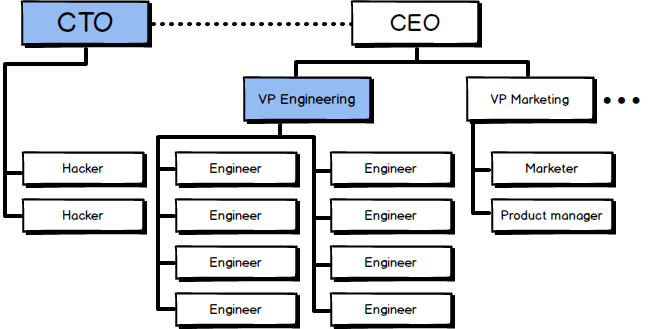
When you’re a small startup jockeying for a position in the market, every new hire can be a make-or-break decision. At this early juncture, some of the most important positions in the company are the lead developer, the VP of engineering and the chief technology officer (CTO). Although these three technical roles are frequently confused, they’re far from interchangeable, with each one having a different yet vital part to play.
If you don’t understand the difference between these three roles, then you also won’t be able to figure out when to hire them at the right time. The correct answer here depends on which stage of the startup life cycle your company is currently in. Learning the distinction between lead developers, VPs of engineering and CTOs will help you bring the right people on board, delivering the value that your startup needs.
What Do These Roles Mean?
Lead Developer
The primary goal of the lead developer (also known as the lead architect) is to build high-quality software. Of the three roles discussed here, the lead developer is the only one that directly touches the code base regularly. Aside from doing a great deal of programming, the lead developer is also responsible for monitoring the overall quality of the code base and ensuring all requirements are implemented correctly and in a timely manner.
VP of Engineering
The next two roles have a more significant impact on the company’s broader outlook and objectives. To begin with, the VP of engineering manages the development team and directs all available efforts toward meeting the deadlines for product delivery. This role is primarily internally focused; candidates for the VP of engineering will have to be good at motivating people and staying on top of things in order to reach the goals that you’ve set.
The VP of engineering is still a job that very much requires deep technical knowledge, such as what kind of testing suites to use or how best to implement agile within your organization. However, VPs of engineering typically spend less time working on the code base and more time dealing with other nontechnical management roles in the organization.
CTO
VPs of engineering and CTOs have a symbiotic relationship: One worries about the team, the other worries about the technology the team uses. The CTO’s main function is to act as a thought leader for the technological direction of your company. For example, CTOs may express an opinion about which JavaScript back-end framework is best to use, or whether your iOS application should be built in Swift or Objective-C.
In a certain sense, the CTO is a more mature version of the lead developer. Indeed, during the very early stages of a startup, CTOs may have to get their hands a little dirty by programming much of the code base themselves. However, as your company expands and you hire more developers, the CTO’s role will likely become less concrete and more abstract.
The Startup Life Cycle Stages
Each of the three roles described above has a valuable part to play in a startup—but perhaps not all at the same time. Instead, the importance of each role depends on which stage your startup is currently in.
Early Stage
The earliest stages of a startup begin when you first come up with an idea, and end once you’ve built a working product. When your startup is in its earliest stages, the lead developer is the most important role. During this time, you should be spending less time thinking about your long-term growth strategy and more time simply getting a minimum viable product out the door.
For this stage, your lead developer will be the one putting in the most work to get your product to market. Since your development team is small — perhaps even only one person — there’s little need for a role like VP of engineering, which is intended to manage the conflicting needs of a variety of people.
Middle Stage
During the middle stages of a startup, you’ve already demonstrated that you have a valid idea, and you’re now looking to obtain your first customers. This means that you’ll probably be developing new features for the product, beyond what’s minimally viable, according to customer demand.
Mid-stage startups are typically more mature than their early-stage counterparts, with more money behind them and more employees on their payroll. As the organization grows in complexity, you’ll need to bring some new people on board who are capable of managing this complexity and thinking past your immediate issues.
Once you’ve hired five developers or so, the team is large enough to require a manager. This usually means adding a VP of engineering at this stage, and may also include adding a CTO depending on your precise needs.
Growth Stage
After you’ve obtained a few reliable customers and come up with a repeatable business model, your startup is in the growth stage. During this stage, you’ll be scaling your product for use by many customers, and also tinkering with your product to distinguish yourself from your competitors.
Normally, startups in the growth stage have all three roles: lead developer, VP of engineering and CTO. Note that one of these last two roles is likely to be filled by your technical co-founder, depending on this person’s specific skills and competencies. If your technical co-founder is a people person who’s good at managing teams, VP of engineering is a natural fit. On the other hand, if this person is a visionary who’s good at seeing the big picture, then CTO is the best choice, and you’ll have to find a VP of engineering elsewhere.

Final Thoughts
You might be tempted to find someone who can play more than one of these three roles at the same time, but this probably isn’t a good approach in the long run. While you want to hire smart, capable people, you also want to avoid overstretching your employees if you can help it.
Are you selling so fast you can’t keep up with demand, or are you still working on a minimum viable product? The stage of your startup determines the roles that you’ll need to have. Knowing the right time to hire your lead developer, VP of engineering and CTO — and how to get the right people for the job — is a critically important task that can have a major impact on your startup’s ultimate success or failure.